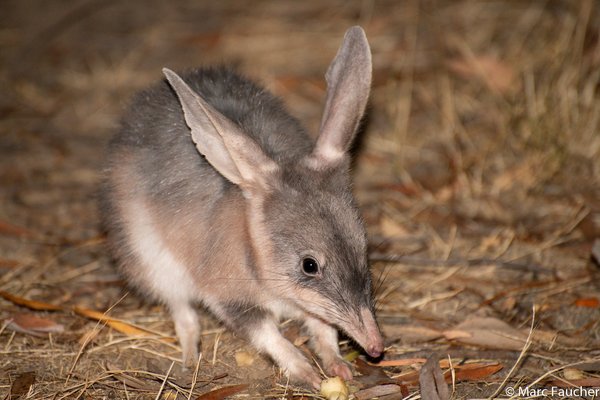What’s that smell? Protecting our wildlife using volatilomes
Australian Centre for Wildlife Genomics and UTS Centre for Forensic Science PhD candidate Amber Brown, and supervising scientists Dr. Greta Frankham, Dr. Maiken Ueland and Dr. Barbara Stuart, have completed a world-first study which optimised the collection and analysis of volatilomes from live reptiles.
If you ever been waiting at the baggage carousel at an airport, chances are that you have probably come across one of Australia’s most hard-working and effective agents. Yes, that’s right, we are talking about the detector dogs who keep our borders safe from biosecurity and criminal risks from both domestic and overseas sources.
While these dogs are extremely effective in performing their jobs, they are expensive to train and keep. Additionally, these animals are generally only trained to detect one or two of a long list of illicit items that are of concern to border agents. These limitations present a unique opportunity to understand how a dog’s nose works and how we can potentially mimic it with technology.
The long list of items of concern for border agents includes high profile items such as drugs, explosives, money, tobacco and plant material/fruits. One of the most valuable is illegally trafficked wildlife, including many iconic Australian reptile species smuggled live for the illegal pet trade.
A world-first study recently published in Forensic Science International: Animals and Environments has focused on studying the methods for improving the detection of live Australian reptiles in transit.

PhD Candidate Amber O. Brown holding a Centralian blue tongue (Tiliqua multifasciata) prior to volatilome sampling.
Image: Andrew Brown© Andrew Brown

Dr. Greta Frankham holding a wild shingleback lizard (Tiliqua rugosa) after volatilome sampling prior to release.
Image: Amber O. Brown© Amber O. Brown

Dr. Maiken Ueland preparing an Eastern Blue Tongue (Tiliqua scincoides) for volatilome sampling.
Image: Amber O. Brown© Amber O. Brown

Dr. Barbara Stuart after capturing a wild shingleback lizard (Tiliqua rugosa) prior to volatilome sampling.
Image: Paul Thomas© Paul Thomas
To do this, we studied volatile organic compounds, which are the chemical compounds responsible for odours that are given off by all items, both natural and synthetic. These are the odours that detection dogs use to find different target items that are hidden within luggage. The total composition of these compounds is known as the “volatilome”; this can be collected and analysed using sophisticated instruments to determine an odour profile for different items, or in our case, for smuggled reptiles. This type of research had never been conducted on living animals. Therefore, the most essential and fundamental step of our research was to optimise both the volatilome collection as well as the analysis methods that would be suitable for a range of different reptile species and individuals. This way, we can be confident that we will be able to determine the most important odorous compounds that can be used for locating these smuggled animals.
After careful consideration and planning, the team designed a container and attached a tube which was capable of collecting volatilomes from captive reptiles. In this work, we sampled Shingleback lizards (Tiliqua rugosa), Eastern Blue Tongues (Tiliqua scincoides) and Children’s pythons (Antaresia childreni) held at Featherdale Wildlife Park. We then designed and tested all the steps from volatilome collection through to analysis for future studies. This included determining which material (coating in the tube) was most suitable to collect reptile odours. We then determined how long it took the animal to generate a stable volatilome profile, as well as how long it took to collect a reproducible volatilome profile. In the lab, we had to optimise how the odour sample was extracted and separated so we could accurately determine the chemical components of each odour.

The team designed a container and attached a tube which was capable of collecting volatilomes from captive reptiles.
Image: Amber O. Brown© Amber O. Brown
Because this technology is being developed to better identify criminal activity, it is critical that it is developed with forensic standards in mind, for which thorough optimisation is essential. As a result of this work, databases of volatilomes can be accurately and reliably built which can serve as the foundation for future volatilome detection technologies.
Amid this pandemic, numerous community research members generously partnered together to complete this study. We are very excited to see what the future holds for this new field in wildlife forensic science!
Amber Brown, PhD candidate, Australian Centre for Wildlife Genomics, Australian Museum; and, University of Technology Sydney.
Dr Greta Frankham, Research Assistant, Australian Centre for Wildlife Genomics, Australian Museum & Industry Fellow Centre for Forensic Science, University of Technology Sydney.
Dr. Maiken Ueland, ARC DECRA Fellow & Senior Lecturer, Centre for Forensic Science, University of Technology Sydney.
Dr. Barbara Stuart, Associate Professor, Centre for Forensic Science, University of Technology Sydney.
Acknowledgments:
Thank you to the staff Chad Staples, Christina Kingsford, Sam Hermann, and Rebecca Gallagher at Featherdale Wildlife Sanctuary for access to their animals as well as Andrew Brown for their assistance with this research. This work was funded through the RSPCA Alan White Scholarship for Animal Welfare Research, the UTS International Research Scholarship and the UTS President’s Scholarship.
More information:
Amber O. Brown, Greta J.Frankham, Barbara H. Stuart, Maiken Ueland. 2021. Reptile volatilome profiling optimisation: A pathway towards forensic applications. Forensic Science International: Animals and Environments, 1:100024. https://doi.org/10.1016/j.fsiae.2021.100024












